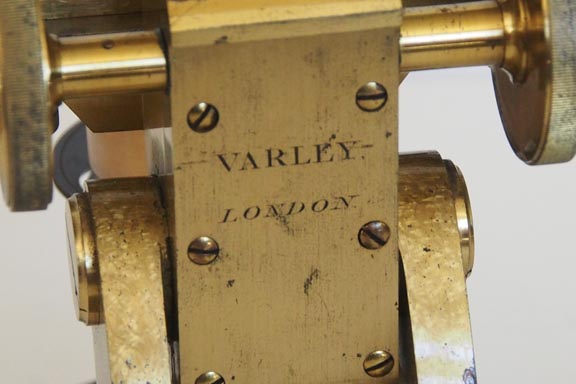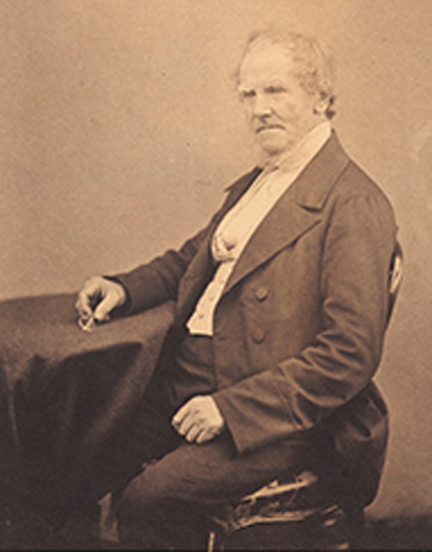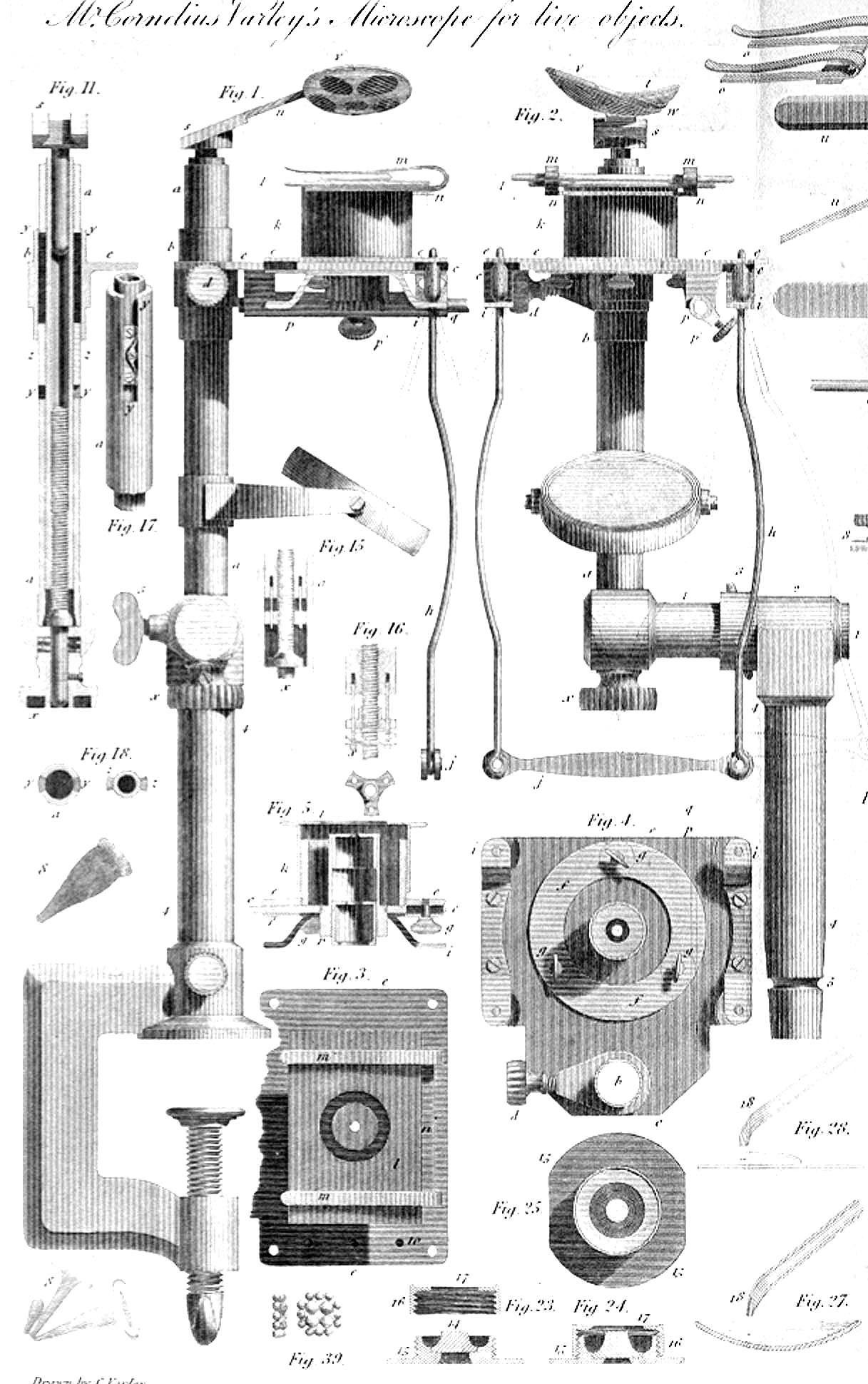| DESCRIPTION | HISTORY |
Please Click On Any Picture for a Larger Version
 This is a bar limb microscope. It arises from a uniquely shaped foot with a
U-shaped base and two uprights curving slightly forward with triangular
cutouts in each. It stands about 440 mm high in the position seen in the images. It is signed 'VARLEY, LONDON on the back of
the pinion box which extends down to form the main attachment to the
uprights. The tailpiece, extending from below that box, has a support
for the mirror at its lower end. The gimbaled mirror is attached to the
support, extending in front of the bottom of the tailpiece. Coarse
focus is by straight rack and pinion, fine via a long lever within the
arm. The arm is made so it can easily rotate 360 degrees which imparts
both an 'aquatic' motion and allows it to be stored in its case turned
180 degrees back on itself. The Varley type of lever stage is
controlled by a single lever extending down on the right side of the
microscope. The original substage fitting has been replaced with an
appropriate substitute sleeve into which the original substage apparatus fits.
This is a bar limb microscope. It arises from a uniquely shaped foot with a
U-shaped base and two uprights curving slightly forward with triangular
cutouts in each. It stands about 440 mm high in the position seen in the images. It is signed 'VARLEY, LONDON on the back of
the pinion box which extends down to form the main attachment to the
uprights. The tailpiece, extending from below that box, has a support
for the mirror at its lower end. The gimbaled mirror is attached to the
support, extending in front of the bottom of the tailpiece. Coarse
focus is by straight rack and pinion, fine via a long lever within the
arm. The arm is made so it can easily rotate 360 degrees which imparts
both an 'aquatic' motion and allows it to be stored in its case turned
180 degrees back on itself. The Varley type of lever stage is
controlled by a single lever extending down on the right side of the
microscope. The original substage fitting has been replaced with an
appropriate substitute sleeve into which the original substage apparatus fits.
 Cornelius
Varley (1781-1873), a well known painter who used mainly watercolors,
was apprenticed to his uncle Samuel, a watchmaker and instrument maker.
He was a prolific inventor of optical apparatus, including his 'Graphic
Telescope' which he patented in 1811. This instrument, a telescopic
form of camera lucida, allows projection of the outline of distant
objects onto a canvas or paper as an aid in drawing. He became keenly
interested in optics and the microscope in particular. He learned how
to grind his own lenses; some of the tools he used for grinding lenses
and some of the lenses themselves are preserved in the Science Museum
in London, (along with five of his microscopes). As a high-ranking
member of the Society of Arts, many of his publications were in the
Transactions of that body.
Cornelius
Varley (1781-1873), a well known painter who used mainly watercolors,
was apprenticed to his uncle Samuel, a watchmaker and instrument maker.
He was a prolific inventor of optical apparatus, including his 'Graphic
Telescope' which he patented in 1811. This instrument, a telescopic
form of camera lucida, allows projection of the outline of distant
objects onto a canvas or paper as an aid in drawing. He became keenly
interested in optics and the microscope in particular. He learned how
to grind his own lenses; some of the tools he used for grinding lenses
and some of the lenses themselves are preserved in the Science Museum
in London, (along with five of his microscopes). As a high-ranking
member of the Society of Arts, many of his publications were in the
Transactions of that body. 
 According to his obituary published in the Monthly
Microscopical Journal and other sources, Varley invented his first
version of the lever-controlled stage, making use of a stirrup-shaped
control, about 1824 for which he received a silver medal from the
Society of Arts; this was a simple (i.e. single lens, not compound)
microscope. Varley invented this device to control the movement of the
stage so that he could follow living organisms. Because the view under
the microscope is reversed right to left and front to back, an organism
appearing to move forward would appear to be moving backward. The lever
allowed the observer to move the stage in the opposite direction to the
lever and so following a moving subject would be simplified. The length
of the lever from the fulcrum is long enough so that small movements
can be accomplished by relatively large movements of the lever. The
earliest illustrations of two of his microscopes that I am aware of are
his 'Microscope for Live Objects' and the first hand-held version of his 'Vial Microscope'
seen in his publication of the Transactions of the Society of Arts, in
1831. The former instrument is shown to the left. Two years later, in
1833, his 'Vial and Animalcule Microscope'
was shown in the same journal, and shown here to the right. This main
stand also had the stirrup control and the main support could be used
for the improved 'Vial Microscope' or the new form of lever stage simple microscope. In both cases, he described his 'Dark Chamber' illumination system, though of slightly different design for the Vial microscope.
According to his obituary published in the Monthly
Microscopical Journal and other sources, Varley invented his first
version of the lever-controlled stage, making use of a stirrup-shaped
control, about 1824 for which he received a silver medal from the
Society of Arts; this was a simple (i.e. single lens, not compound)
microscope. Varley invented this device to control the movement of the
stage so that he could follow living organisms. Because the view under
the microscope is reversed right to left and front to back, an organism
appearing to move forward would appear to be moving backward. The lever
allowed the observer to move the stage in the opposite direction to the
lever and so following a moving subject would be simplified. The length
of the lever from the fulcrum is long enough so that small movements
can be accomplished by relatively large movements of the lever. The
earliest illustrations of two of his microscopes that I am aware of are
his 'Microscope for Live Objects' and the first hand-held version of his 'Vial Microscope'
seen in his publication of the Transactions of the Society of Arts, in
1831. The former instrument is shown to the left. Two years later, in
1833, his 'Vial and Animalcule Microscope'
was shown in the same journal, and shown here to the right. This main
stand also had the stirrup control and the main support could be used
for the improved 'Vial Microscope' or the new form of lever stage simple microscope. In both cases, he described his 'Dark Chamber' illumination system, though of slightly different design for the Vial microscope.